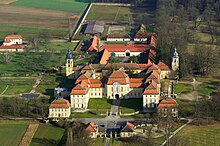Amand von Buseck

Friedrich Franz Ludwig von Buseck OSB (born February 2, 1685 in Eppelborn , † December 4, 1756 in Fulda ) was Prince Abbot of the Imperial Abbey of Fulda from 1737 under the name of the order Amand von Buseck , and from 1752 the first Prince-Bishop in Fulda .
family
Amand von Buseck was the eldest son of Philipp Franz Edmund von Buseck and his wife Maria Antonia Amalia, a born von Fechenbach . His brother Johann Christoph von Buseck was Commander of the Teutonic Order in Horneck, his nephew Christoph Franz von Buseck was the last Prince-Bishop of Bamberg.
Career
In 1695 von Buseck came to live with his great uncle Bonifatius von Buseck in Fulda. In 1697 he began his studies at the Jesuit grammar school there. In 1700 he became the page of Abbot Adalbert von Schleifras . In 1704 he entered the Fulda Abbey and made his profession the following year . Around 1708/09 he was ordained a priest in Erfurt.
In 1710, von Buseck was included in the chapter of Fulda Abbey. His election as Stiftseankan and thus also Provost of Neuenberg took place in 1724. Pope Benedict XIII. appointed him in 1728 titular bishop of Themiscyra and auxiliary bishop in Fulda. In 1736 he became Rector Magnificus of the University of Fulda, which was newly founded from the Jesuit University . A year later he was elected prince abbot of Fulda. The election was made in 1738 by Pope Clement XII. approved. In 1739 the regalia were officially confirmed . After the Abbey of Fulda was elevated to the status of the Diocese of Fulda , Amand von Buseck was appointed Prince-Bishop in 1752.
Act
After being accepted into the monastery, von Buseck undertook numerous trips, including a study trip to Holland, Flanders, Paris, Lorraine and Alsace in 1715. He was interested in architecture, garden art and genealogy . In the Marburg State Archives there is a large collection of genealogical notes on various noble families in the Busecks estate. He also left drawings of many tombstones, which today represent an invaluable resource for family researchers.
With the election to the monastery dean, he was increasingly involved in the secular business of the monastery. When he took office as prince abbot, he took over the debts of his predecessors. A great credit to him is the consolidation of this debt. He promoted the craft, and numerous factory-ups back to him, a Fayencerie , which was characterized by high-quality pottery with porzellanartigem character, a wool and Stuckmanufaktur and a damask weaving. In Brückenau he had the salt water springs closed and thus founded the spa business.
Due to his interest in architecture and his drawing skills, von Buseck drew the designs of his most important building projects himself. One of the most important buildings commissioned by him is the expansion of the Fasanerie Palace south of Fulda. Numerous parishes in the monastery territory got a new church building or a church renovation under his rule, for example St. Peter and Paul in Salmünster .
In 1742 von Buseck participated in the coronation ceremony of Empress Maria Amalia of Austria .
The city of Fulda has dedicated a street to Amand von Buseck in which the Fulda Music School is located.
literature
- Joachim Conrad: Amand von Buseck. In: Biographisch-Bibliographisches Kirchenlexikon (BBKL). Volume 23, Bautz, Nordhausen 2004, ISBN 3-88309-155-3 , Sp. 182-187.
- Josef Leinweber: The Fulda abbots and bishops . Knecht, Frankfurt am Main 1989, ISBN 3-7820-0585-6 , pp. 155–157.
- Michael Müller: The Fulda prince-bishop Amand von Buseck (1737 - 1756) , in: Archive for Middle Rhine Church History , 53 (2001), pp. 349–364.
- Michael Mott : Römershag and his Buseck coat of arms , in: Buchenblätter Fuldaer Zeitung , 73rd year, No. 21, 24 Aug. 2000, pp. 82, 83.
- Michael Mott: The Princely "Fayence- und Porcellainfabrique" / Today the courtyard of the old tax office / Traces in the sandstone wall , in: Fuldaer Zeitung , March 14, 2001, p. 18 (Series: Fulda once and now).
Web links
- Entry on catholic-hierarchy.org (English)
- Amand von Buseck in the Saarland biographies
- Tripota - Trier portrait database
| predecessor | Office | successor |
|---|---|---|
| Adolf von Dalberg |
Prince Abbot of Fulda 1737–1756 |
Adalbert II von Walderdorff |
| --- |
Prince-Bishop of Fulda 1752–1756 |
Adalbert II von Walderdorff |
| personal data | |
|---|---|
| SURNAME | Buseck, Amand von |
| ALTERNATIVE NAMES | Buseck, Friedrich Franz Ludwig von (birth name) |
| BRIEF DESCRIPTION | first prince-bishop in Fulda |
| DATE OF BIRTH | February 2, 1685 |
| PLACE OF BIRTH | Eppelborn |
| DATE OF DEATH | December 4, 1756 |
| Place of death | Fulda |

